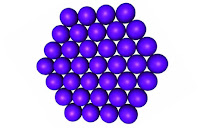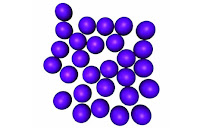 part one of the lab
part one of the lab part two of the lab
part two of the lab data collected from lab completed in class
data collected from lab completed in classThe lab todaywas the Rutherford Simulation Lab, in the lab we took a piece af paper with six circles on it, and six small squares at the center of each circle. We layed a piece of carbon paper on top, and with a partner, bounced a marble on top of the paper 110-120 times. After we finished, we counted the number of dots: in the circles, in the squares, and out side of the circles.
Using the collected information we found various data, like the percentage of dots that landed in the circles, for example me and my partner got 69 dots in the circle, out of 120 dots. to get the percent divide the number dots in the circle to the number of total dots: 69/120=.575 or 57.5%.
then using the total area of the paper, 93.5in. sq., and the percent of dots that landed in the circle, we found an estimated area of all 6 circles. We did this by multiplying the area of the paper times the percentage in decimal form: 93.5*.575=53.76in. sq.
Using the information we just found, we divided by six to find the next question, which was, what is the area of one circle: 53.76/6=8.96in. sq.
Then we solved to find the radius. To do this divide bothe sides by pi, then the square of your answer. To solve for diameter, multiply the answer you just got by 2. 8.96/3.14159=2.85 then the square of 2.85= 1.689in is your radius. 1.689*2= 3.378in is your diameter.
For problem 7, use a similar process to find the area of a square, like finding the area of a circle. First divide the number of dots in the squares by 120, i got 2/120=1.56, then divided by 6 to get one squarer alone. 1.56/6=.259in. sq.
to find the length of a side, take the square root of the area of one square.
Question Answers:
What does the paper represent?
the gold foil
What does the circle represent?
the atom
What does the marble represent?
the alpha-particle
What does the square represent?
the nucleus of the atom
The true diameter of each circle is 3.2 inches. find your percent error. to do this subtract your value minus the true value, then divide by the true value, and multiply by 100.
>>> (3.378)-(3.2)=.178/3.2=.055625*100=5.5625%
What could account for your own error in this lab?
>>>answers may differ. ex: not enough data collected.
Homework: Finish Question Four of the Lab, Test next Friday, October 8th, 2010





























 For number 7, we were given the following formulas, and we had to draw a picture to match them. We used the same key that we used for number 6. For number 8, we were given pictures, and we had to write the formula and a description to match the picture. It's the opposite of what we had to do in number 7, but we also had to write a description. The description is basically a list of terms that appeared in the picture. The terms that we could use were atom, molecule, element, compound, pure substance and mixture.
For number 7, we were given the following formulas, and we had to draw a picture to match them. We used the same key that we used for number 6. For number 8, we were given pictures, and we had to write the formula and a description to match the picture. It's the opposite of what we had to do in number 7, but we also had to write a description. The description is basically a list of terms that appeared in the picture. The terms that we could use were atom, molecule, element, compound, pure substance and mixture. The last page has numbers 9 through 13, but we were only told to go up to number 9. In number 6, we were given a formula, and had to draw a matching picture. In number 7, we were given a sample, and had to write the formula and description. Now, in number 9, we're given a formula, and have to draw a matching picture and description.
The last page has numbers 9 through 13, but we were only told to go up to number 9. In number 6, we were given a formula, and had to draw a matching picture. In number 7, we were given a sample, and had to write the formula and description. Now, in number 9, we're given a formula, and have to draw a matching picture and description. 






